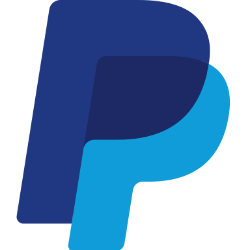Overall, PayPal demonstrates strong business quality through its solid financial performance, innovative product offerings, and strategic partnerships, although it faces challenges from market conditions and client renegotiations. The future prospects remain positive with a focus on innovation and growth initiatives, but market uncertainties could pose risks.
Analysis Date: February 4, 2025
Last Updated: March 12, 2025
Trailing Twelve Months (TTM) values provide a view of the company's performance over the last year.
Graham Value Metrics
Benjamin Graham's value investing approach focuses on finding stocks with a significant margin of safety between their intrinsic value and market price.
Intrinsic Value
Estimated fair value based on Graham's formula
$131.13
Current Market Price: $57.92
IV/P Ratio: 2.26x (>1.0 indicates undervalued)
Margin of Safety
Gap between intrinsic value and market price
56.00000000000001%
Graham recommended a minimum of 20-30% margin of safety
Higher values indicate a greater potential discount to fair value
ROE: 20.250259415247513
ROA: 1.3735893445736482
Gross Profit Margin: 43.25863913891862
Net Profit Margin: 13.051551583055328
Trailing Twelve Months (TTM) values provide a view of the company's performance over the last year.
Strong Return on Equity
A return on equity (ROE) of 20.25% reflects effective management and the ability to generate profits from shareholders' equity.
Healthy Gross Profit Margin
43.26%
Gross Profit Margin
The gross profit margin of 43.26% indicates strong sales efficiency, allowing the company to retain a significant portion of sales as gross profit.
Moderate Net Profit Margin
The net profit margin of 13.05% is respectable but could be improved to reflect better overall profitability.
About Profitability Metrics
Profitability metrics measure a company's ability to generate earnings relative to its revenue, operating costs, and other relevant metrics. Higher values generally indicate better performance.
Return on Equity (ROE)
Measures how efficiently a company uses its equity to generate profits
20.25%
10%
15%
Higher values indicate better returns for shareholders
TTM (as of 2025-04-16)
Return on Assets (ROA)
Measures how efficiently a company uses its assets to generate profits
1.37%
3%
7%
Higher values indicate better asset utilization
TTM (as of 2025-04-16)
Gross Profit Margin
Percentage of revenue retained after accounting for cost of goods sold
43.26%
20%
40%
Higher values indicate better efficiency in production
TTM (as of 2025-04-16)
Net Profit Margin
Percentage of revenue retained after accounting for all expenses
13.05%
8%
15%
Higher values indicate better overall profitability
TTM (as of 2025-04-16)
Low Debt-to-Equity Ratio
0.48
Debt-to-Equity Ratio
A debt-to-equity ratio of 0.48 indicates a conservative approach to leverage, suggesting financial stability and lower risk.
Strong Interest Coverage
14.73
Interest Coverage Ratio
An interest coverage ratio of 14.73 signifies that the company comfortably meets its interest obligations, reflecting strong financial health.
Low Cash Ratio
The cash ratio of 0.14 suggests limited liquidity, which may hinder the company’s ability to cover short-term obligations.
About Financial Health Metrics
Financial health metrics assess a company's ability to meet its financial obligations and its overall financial stability.
Debt to Equity Ratio
Total debt divided by total equity
0.48x
1.0x
2.0x
Lower values indicate less financial leverage and risk
Less than 1.0 is conservative, 1.0-2.0 is moderate, >2.0 indicates high risk
Q4 2024
Current Ratio
Current assets divided by current liabilities
1.26x
1.0x
2.0x
Higher values indicate better short-term liquidity
Less than 1.0 is concerning, 1.0-2.0 is adequate, greater than 2.0 is good
Q4 2024


